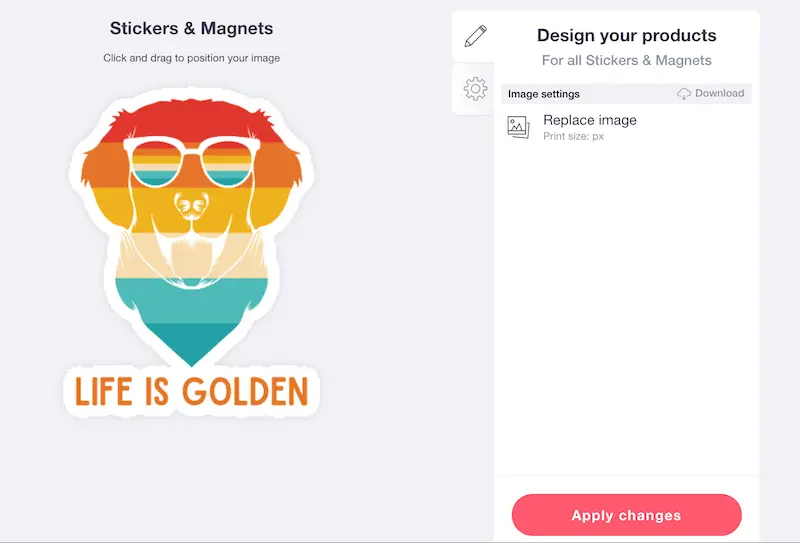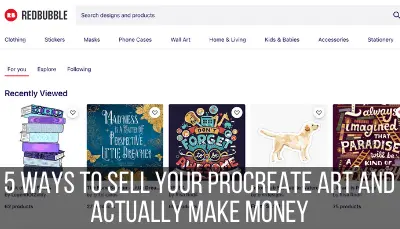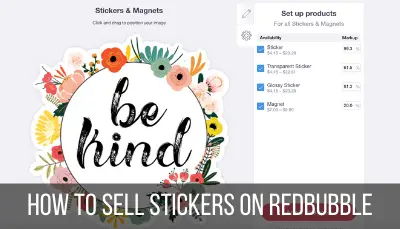Teepublic and Redbubble are both great platforms for artists, designers, and creators to sell their work and bring in passive income. I’m personally a seller on both of these print on demand platforms and love how they each offer unique features, products, vibes, and more.
Artists and sellers should diversify their income by building portfolios both with TeePublic and Redbubble. One platform isn’t better than the other, but they both have unique characteristics and audiences that can help you maximize your reach and profits.
If you’re wondering about who would win the fight between TeePublic vs. Redbubble, you’re asking the wrong question. In fact, if you don’t build up portfolios with both of them, it’s you that will lose the fight in growing your passive income as an artist.
TeePublic and Redbubble both have a lot to offer and can play an important role in diversifying your online, passive income. Luckily, it’s free to have accounts with both platforms, so there’s no risk to signing up.
This post may contain affiliate links, which means I may earn a commission if you decide to purchase through my links.
Sign up for TeePublic here
Sign up for Redbubble here
Of course, neither print on demand platforms are perfect. We’re diving into the important pros and cons you should be aware of once you start working with both TeePublic and Redbubble so that you’re best prepared to have success with your online stores.
The Pros of TeePublic
TeePublic is a growing platform that is starting to make a name for itself in the print on demand world. It offers a great opportunity for artists, designers, and sellers to build their portfolios on this simple, sleak, and innovative platform.
What I love about TeePublic is that it’s easy to use (you’ll see that this is a pro of Redbubble as well).
When you’ve had a long day, but you still want to be productive, you can zone out in front of Netflix and upload designs to TeePublic. Yep, it’s that easy. Simply upload your design once and you’ll be able to apply it to all of the products that TeePublic has to offer.

And, once you’ve uploaded a design, you’re done. If an order comes in, TeePublic will handle everything from processing the order to dealing with any customer support issues. There’s no hands on work for you!
As long as you optimize your titles, tags, and descriptions in a way that will help them be discovered by customers, you can bring in money from your TeePublic designs without any effort. It’s ideal to revisit any listings that aren’t making sales so that you can adjust their titles, tags, and descriptions for better success. That said, aside from general maintenance, you won’t need to micromanage your designs once you’ve uploaded them.
Given how simple it is to upload designs to TeePublic, I’ve gotten in the habit of making it a part of my uploading routine. When I create a design, I upload it to Merch by Amazon, Redbubble, and then TeePublic.
Usually, I find that TeePublic is the quickest out of the 3. They have fewer text boxes than Merch by Amazon and fewer products than Redbubble. Combined with their simple interface, this makes it quick and easy to upload designs.
As we’ll talk about in the next section, TeePublic may not be your biggest money maker but, given how quick it is to upload designs to their platform, it’s worth it to build up your portfolio there. Heck, who wants to turn down a few extra bucks? Not me!
The Cons of TeePublic
TeePublic does not allow sellers to control their own pricing, which can lead to lower profit margins, especially during sitewide sales. The lack of control over the product pricing is the biggest downside to TeePublic that does not make it a reliable income source.
By far, the biggest downside to TeePublic is their pricing structure. Unlike other platforms where sellers can determine their own prices, TeePublic does not. Product prices are determined by TeePublic, which means that your profit margins are as well.
While profits for apparel aren’t that bad (in the $5 range), you’ll find that you only make about 50 cents for a magnet or sticker. It’s almost insulting, especially since you can’t change it.
It’s also important to remember that TeePublic can run a sitewide sale at any time.
This means that your profit margins could be cut in half at any time, for any length of time, when TeePublic decides to run a sale.
I’m hoping that TeePublic will change their pricing system in the future. I can see the perk from the customer end of having all products offered at the same price sitewide, but it really does limit the autonomy and control that sellers have.
I have a full guide on whether TeePublic is worth it for artists or not that you can check out if you want to learn more about their pricing structure.
Aside from pricing, the other con of TeePublic is that it isn’t as big as the other platforms. It hasn’t built up the reputation that many other platforms have, which can limit the customers coming through to purchase your products.
That’s ok though. TeePublic is growing. And, due to something we’ll talk about at the end, I believe that TeePublic is going in a very exciting direction. I think we’ll all be happy for having built up our stores with them now, in its early days.
The Pros of Redbubble
Redbubble is a print on demand platform known for its artsy vibe where artists can really shine. They shine in their ability to bring organic traffic to listings, allow sellers to set their own prices, and add their designs to a large number of products.
I LOVE Redbubble! I’ve been growing my portfolio with them for a couple of years now and have found it to be a really fun and easy way to bring in some extra income.
Like TeePublic, anyone can sell on Redbubble, which makes it a great opportunity for artists who want to get started earning more from their work. You can make beautiful collections, establish your own product prices, and even buy your own products if you’re looking for a treat for yourself.
If you’re an artist, you won’t want to pass up Redbubble. As a platform, they are known for their quirky and artsy vibe. It’s where customers go to find unique gifts that they can’t find anywhere else. It’s a place where art is celebrated!
Similar to TeePublic, their platform is really easy to use. Simply upload your design once and you’ll be able to apply it to all of the products they have to offer. The reason why uploading to Redbubble takes longer than TeePublic is because they currently offer more products. You’ll have to go through each one to make sure that your design is positioned correctly.
Even though it will take you a few more minutes during the upload process, the fact that Redbubble has SO many products is a big perk.
When you upload your design, you’ll be able to apply it to a large number of products including apparel, shower curtains, bags, stickers, and more.
I have a complete guide about uploading stickers to Redbubble that you can read to learn more.

The more products you upload your designs to, the more chances you have for your art to be found by your future customers.
Another great thing about Redbubble is that they’re really good about bringing in traffic to your listings. They really know what they’re doing in regards to advertising and populating customer dashboards with new artists and products to follow.
As long as your titles, tags, and descriptions are optimized, your art has a great chance of being discovered. In my experience, Redbubble is better at this than TeePublic.
The other great thing about Redbubble is that you can control your pricing. If you want to increase your prices in an effort to make higher profit margins, you can! While your profit will vary depending on where your product was sold and is being shipped to, you have MUCH more control of your income with Redbubble than you do with TeePublic.
This control over pricing can make you feel more autonomous as an artist and seller, which is a great thing.
The Cons of Redbubble
Like any platform, there are always downsides, and Redbubble isn’t an exception. The platform is becoming saturated, which means that it takes more strategy to get discovered. They’ve also introduced hefty account fees which make the decision to sell on Redbubble more murky.
As platforms grow in popularity, you get the benefit of more customers discovering. That said, you also get the downside of it becoming saturated. By no means is Redbubble as saturated as Merch by Amazon, but there’s no doubt that more and more designers are discovering it as time goes on.
It’s not really a downside as much as it is a natural part of selling online.
Just be mindful of optimizing your titles, tags, and descriptions in order for your designs to be found.
Also, keep the fees in mind.
In 2023, Redbubble introduced a new tier system. While this introduced some benefits, the main thing it introduced were hefty fees. If you’re wondering if it’s worth it to sell on Redbubble, I suggest reviewing these fees and seeing if they are a dealbreaker for you.
Personally, I was frustrated when I first learned about these fees. They seem exorbitantly high without good reason.
You can read more about these fees here to see if they are a deal breaker for you and your online merch business.
Ok, so now that we’ve talked about the pros and cons of both Redbubble and TeePublic, let’s talk about a big reason why I think you should build up your portfolios with both platforms. Aside from diversifying your income, which is a natural reason to use multiple platforms, here’s why TeePublic and Redbubble are specifically so good to use together.
TeePublic and Redbubble are Sister Sites
In 2018, Redbubble acquired TeePublic.
Given how much I love Redbubble, I’m excited to see how this partnership will impact TeePublic and the print on demand world overall. While I personally have zero clue of what could happen in the future, I’m excited about continuing to build my portfolios with both platforms and see where it leads.

Diana has been an artist for over 27 years and has training in drawing, painting, digital drawing and graphic design. Diana’s latest obsession is digitally drawing with Procreate and Procreate Dreams. Diana has experience selling her art across a number of platforms and loves helping other artists learn how to make money from their art as well.



